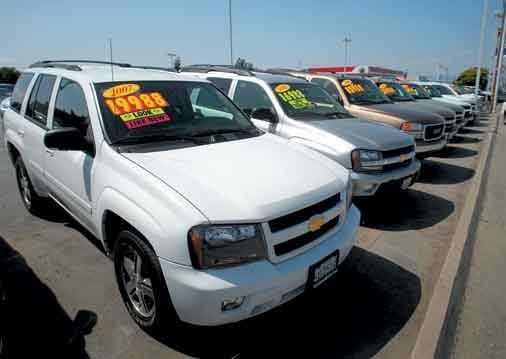With gas prices rising toward an inevitable $4 per gallon, the
resale value of fuel-chugging sport utility vehicles in the South
Valley is sinking as owners abandon ship.
With gas prices rising toward an inevitable $4 per gallon, the resale value of fuel-chugging sport utility vehicles in the South Valley is sinking as owners abandon ship.
Where once Chevy Suburbans and Ford Expeditions ruled the road, statistics provided by JD Power and Associates show a 29 percent drop in SUV sales since 2003. Meanwhile, sales of cars like the Honda CR-V and Dodge Journey, part of the sporty Crossover Utility Vehicle (CUV) line, have increased by a whopping 64 percent over those same years.
Dealerships are offering less and less for trade-ins of the unwelcome behemoths as the market has become flooded with SUVs for sale.
“We’ve had SUVs sit on the lot for a year or more. We couldn’t get rid of them,” said Greg Zazueta, a sales agent at Greenwood Chevrolet-Pontiac-Buick-GMC in Hollister. “Everybody wants to get out of the gas guzzler.”
Brian Greenwood, sales manager at South County Chrystler-Jeep-Dodge in Gilroy, agreed with Zazueta but said while people may be “surprised” when they hear the low trade-in values of their used SUVs, they understand it as another bad result of record-high gas prices.
A Chevy Suburban’s 35-gallon tank would cost $140 to fill with $4 per-gallon gasoline, and at about 15 miles per gallon, drivers pay 27 cents for every mile they drive. This kind of math, paired with an ailing economy, means more people are opting for small cars with better gas mileage.
“It ridiculous,” said Mellissa Rodriguez, an employee at Designing Women Health and Fitness in Hollister, while pulling her Chevy Suburban out of the gas station. “I put $25 in at a time and try not to drive it too much. It’s a waste of money. I want to trade it in for a hybrid.”
But while small car sales reached record highs last year, people still have kids to take to soccer practice and boats to haul to the lake. For this, they are ditching their Jeep Cherokees and Chevy Trailblazers for Ford Escapes, Saturn Vues and the rest of the smaller, more economical CUVs.
Crossovers typically have a smaller frame and less horsepower than their big brother, the SUVs. But with the Honda CR-V racking up 27 miles per gallon on the highway and the rest not far behind, the savings at the pump are hard to pass by.
Steve Schipper, a “born-and-raised” Hollister native, is the sales manager at Greenwood Chevrolet. He said Chevrolet Suburbans and GMC Denalis are the most difficult to sell and that while there will always be a need for large SUVs, the days of bigger-is-better have faded.
“People are parking their SUVs and driving their cars,” Schipper said. “I think there will always be a need for some people to own them (SUVs), but that number has definitely gotten smaller.”
In its heyday, the SUV owned 17 percent of the auto market with 2.8 million vehicles sold in 2003. But from 2003 on, SUV sales dropped each year, down to 2 million in 2007. At the same time, the sporty crossover’s popularity grew enormously.
In 2000, less than 700,000 CUVs were sold compared with the more than 2.7 million SUVs sold the same year. Each year, the CUV have made sales gains until today, when the roles have nearly been reversed, with more than 2.6 million CUVs sold in 2007 compared with only 2 million SUVs sold.
The same data showed the resale price of large SUVs drop more than $2,000 in the last seven months, while the CUVs resale price dipped only slightly.
“We’ve seen the people trading their SUVs in, but we haven’t seen the mass exodus yet,” Schipper said. “But if gas hits $5 per gallon, we still may.”













